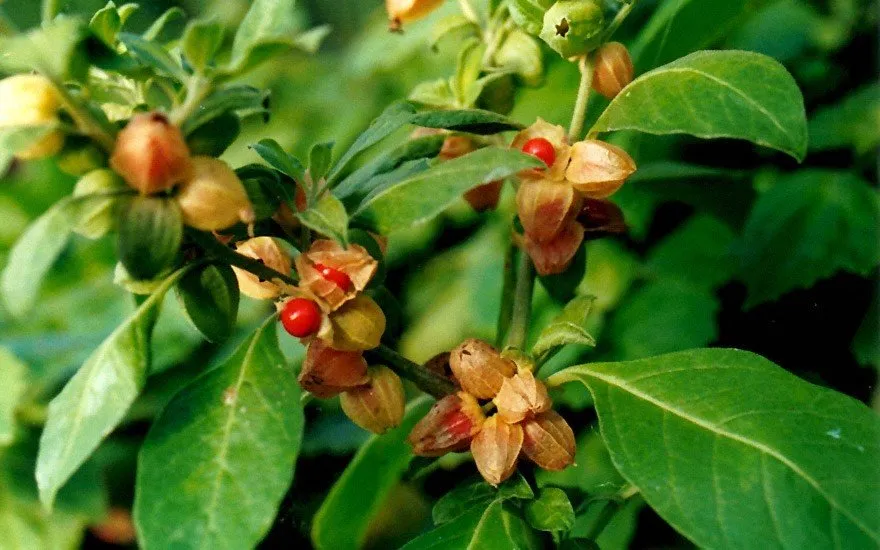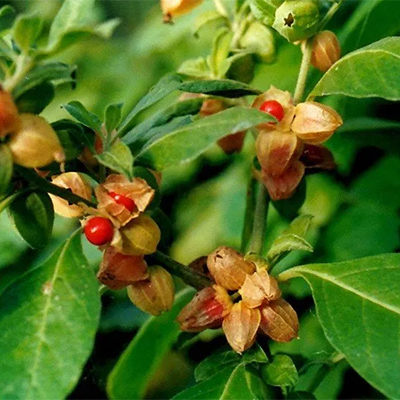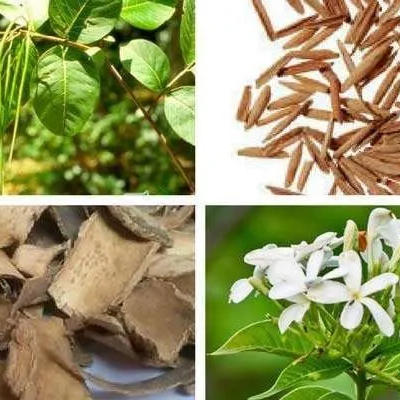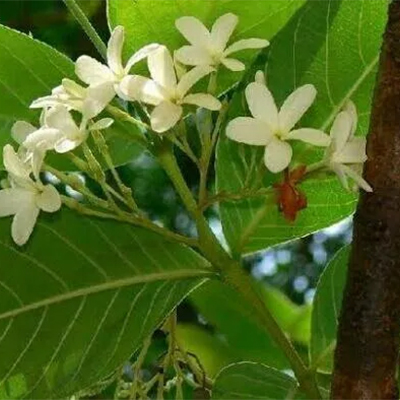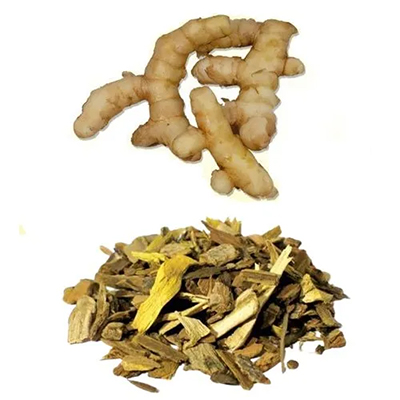On This Page
Ashwagandha (Withania somnifera) – The King of Ayurvedic Herbs
Introduction
In the Ayurvedic system of medicine, Ashwagandha is a very revered herb as a Rasayana (tonic). Ashwagandha is not only famous for its action on the reproductive system to promote healthy sexual and reproductive balance but it also enhances the function of the nervous system, and brain and improves memory. Ashwagandha botanically known as Withania somnifera is a small evergreen shrub that exhibits various actions like anti-stress, anti-inflammatory, thyro- protective, hypoglycemic, sedative activity, etc. Ashwagandha is largely found in Asia, and Africa and is cultivated in India on large scale mainly in Madhya Pradesh.
Basonym of Ashwagandha
अश्व स्येव गन्धो अस्या: अथवा अश्व स्येव गंध उत्साह: काम वेग: यस्या: सेवनेन सा।
The root has the smell of a horse and also improves the sexual potency of the person who consumes it.
Synonyms of Ashwagandha
- According to morphology
गंध पत्री – पत्राणाम अप्य अश्व गन्धी त्वात।
Leaves to have the smell of a horse.
वाराह कर्णी – वाराह कर्ण वत पत्राणा अस्या: ।
The leaves of Ashwagandha resemble Pig’s ears.
अश्व कंद: – अश्वस्य गंध युक्त अश्व स्थैत्व काम शक्ति प्रद: कन्द मूल अस्या:।
The root smells like the horse or on consumption, imparts sexual power like a horse.
- According to action and properties
अश्व अवरोहक – अश्वम अवरोहयति अध् करोति पुंसत्व शक्तौ इति।
Promotes sexual power better than the horse.
कञ्चुका – कंचते बध्नाति शुक्रम दीप्ति करञ्च।
Ashwagandha increases and retains Shukra.
काम रूपिणी – काम स्येव रूपम भवत्य यस्या।
Give a good look to the person who consumes it.
पुत्रदा – पुत्रं ददाति शुक्र वर्धक त्वात।
Which increases the potency and quality of the Shukra thereby increasing the chances of progeny.
बलदा – बलं ददाति बल वर्धन इत्यर्थ।
It imparts strength.
मारुतघनि – मारुतं वात विकारं हन्ति।
Useful in Vataja disorders
वृषा -वृष वत शुक्र वर्धनी वाजिकरी च।
Increases sexual potency
Regional Names of Ashwagandha
- Winter cherry, Indian Ginseng (English)
- Asagandh (Hindi)
- Hiremaddina Gidda (Kannada)
- Amukkuram (Malayalam)
- Askandha (Marathi)
- Aasandh (Gujarati)
- Amukara (Tamil)
- Penneru Gadda or Dommadolu Gadda (Telugu)
Botanical Name
Withania somnifera L.
Here Withania is derived from the scientist name Withan and Somnifera means one that produces sleep.
Family
Solanaceae (Kantkari Kula)
Ayurveda Reference for Ashwagandha (Withania somnifera L.)
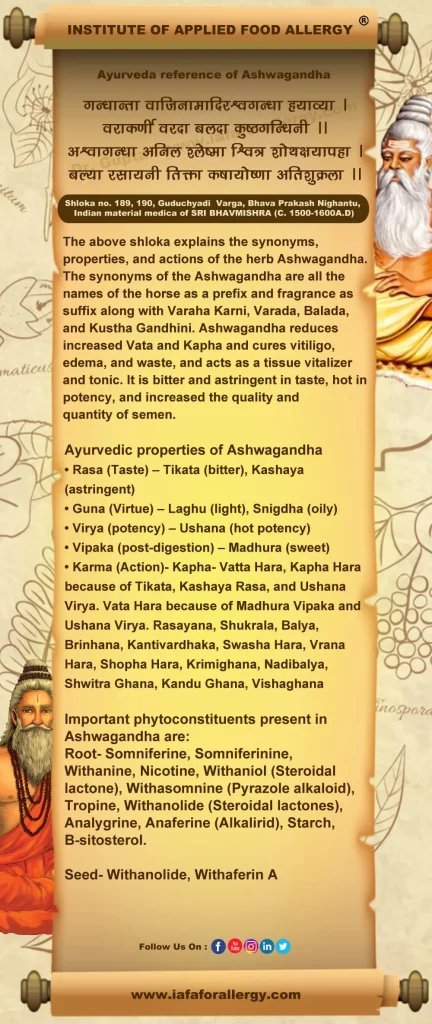
Scientific Classification of Ashwagandha
| Kingdom | Plantae |
| Class | Dicotyledons |
| Subclass | Gamopetalae |
| Series | Bicarpellate |
| Order | Polemoniales |
| Family | Solanaceae |
| Genus | Withania |
| Species | somnifera |
Classification of Ashwagandha as per Charaka and Sushruta
- Charaka: Balya Mahakshaya, Brihaniya Mahakshaya, Madhura Skandha
- Sushruta
Ashwagandha’s Description in Brihtrayi
| Charaka | Shusruta | Vagbhata
(Ashtang Hridya) |
| C. S. Su. 3/ 7, 8 | S. S. Su. 15/ 33 | A. H. Sa. 2/ 50 |
| C. S. Su. 4/ 2, 7 | S. S. Su. 16/ 20, 22 | A. H. Chi. 3/ 122, 133 |
| C. S. Su. 25/ 49 | S. S. Su. 36/ 6, 24, 31 | A. H. Chi. 5/ 25, 79 |
| C. S. Vi. 8/ 144, 146 | S. S. Su. 39/ 3 | A. H. Chi. 8/ 19 |
| C. S. Chi. 2-1/ 34 | S. S. Su. 46/ 432 | A. H. Chi. 13/ 41 |
| C. S. Chi. 3/ 266 | S. S. Chi. 5/ 10 | A. H. Chi. 14/ 14 |
| C. S. Chi. 8/ 175 | S. S. Chi. 15/ 33 | A. H. Chi. 19/ 65 |
| C. S. Chi. 13/ 108 | S. S. Chi. 17/ 14 | A. H. Ka. 4/ 7, 54 |
| C. S. Chi. 14/ 51 | S. S. Chi. 25/ 14, 18, 26 | A. H. U. 2/ 50, 52, 55 |
| C. S. Chi. 17/ 116 | S. S. Chi. 37/ 17 | A. H. U. 3/ 54 |
| C. S. Chi. 18/ 74 | S. S. Ka. 8/ 51 | A. H. U. 5/ 15 |
| C. S. Chi. 21/ 123 | S. S. U. 17/ 34 | A. H. U. 18/ 45, 56 |
| C. S. Chi. 23/ 69, 79, 242 | S. S. U. 21/ 6 | A. H. U. 25/ 47, 52 |
| C. S. Chi. 27/ 41, 48 | S. S. U. 31/ 3 | A. H. U. 39/ 157 |
| C. S. Chi. 28/ 164, 168 | S. S. U. 41/ 41, 49 | A. H. U. 40/ 14 |
| C. S. Chi. 29/ 72 | S. S. U. 45/ 40 | |
| C. S. Si. 3/ 37 | ||
| C. S. Si. 4/ 3 | ||
| C. S. Si. 9/ 92 | ||
| C. S. Si. 12/ 31, 55 |
Ashwagandha’s Description in Brihtrayi as Turanga Gandha
- Shusruta Samhita- S. S. U. 41/ 41, 43
Ashwagandha’s Description in Brihtrayi as Vaaji Gandha
- Shusruta Samhita- S. S. Chi. 37/ 12, 20, S. S. Chi. 38/ 42, S. S. U. 41/ 42, S. S. U. 62/ 27
- Vagbhata- A. H. Chi. 4/ 39, A. H. U. 34/ 64
Ashwagandha’s Description in Brihtrayi as Haya Havya
- Charaka Samhita – C. S. Chi. 28/ 170
- Vaghbhata – A. H. Chi. 17/ 37, A. H. U. 18/ 39
Ashwagandha’s Description in Brihtrayi as Hari Gandha
- Shusruta Samhita- S. S. U. 35/ 4
Historical Background of Ashwagandha
According to Paippalada Samhita, Ashwagandha root juice is given as Nasya to achieve conception (P. S. 1/ 89/ 3). It is a well-documented herb in ancient Indian medicine and is considered a panacea. Among the Brhatrayi texts, Charaka and Vagbhata have called it a Hayagandha or Hayahvaya whereas Sushruta did not. Similarly, Vajigandha is the synonym used by Susruta and Vagbhata but not by Charka. Twice Sushruta alone used another synonym Turangagandha. Charka considered it as Balya and Brihana whereas Sushruta and Vagbhata have not described it in their Ganas/ Vargas. On review of literature on Vrishya drugs, Bihatrayi did not emphasize Ashwagandha as Vrishya (When used individually) in their Works. It is Sharangdhara who highlighted the Shukrala properties of Ashwagandha along with Mushali and Shatavari (Sharangdhara Samhita, Purva Khanda. 5). Brhatrayi has emphasized Asvatha as a Vajikarana Dravya but not Ashwagandha. From the medieval period, onwards Ashwagandha emerged as a general tonic and aphrodisiac agent. However, it is classically a wonder remedy for Amavata and Sandhivata. In classical literature, it is also used for Vatavyadhi, Kasa, Shvasa, Sotha, Shvitra, Kshaya, etc.
Varieties of Ashwagandha
In the literature, we do not come across the descriptions regarding two kinds of Ashwagandha but there are two plants available in the trade i.e W. somnifera and W. coagulans. The former is denoted as Pennerugadda while the latter is known as Pommadolugadda in Telugu. But both the names are commonly used as vernacular to Ashwagandha. In Dhanvantari Nighantu along with Ashwagandha, one another herb with the synonyms like Bali, Medasvi, Sthoulyadhava, Rukmini, and Mamsi was mentioned. This is considered the big variety of Ashwagandha (W. coagulans) by Sri Singaraja Kama Sastry (1932). The cultivated variety of Ashwagandha which is thin, and lead is mainly brought from Nagor dist. of Madhya Pradesh. Hence the name ‘Nagori variety’ The presently cultivated varieties are Poshita, WS- 27- 7, WS- 23- 55, WS- 10- 28, WS- 27- 58 etc.
So, we can say that there are two sources of Ashwagandha Wild and Cultivation. The variety that is cultivated in the Nagor district is Nagauri Aswagandha with the botanical name Withania ashwagandha. The cultivated plant produce is marketed and used commonly in medicine, especially for internal use. The wild plant roots possessing sedative, diuretic, and other properties are preferred only for external application. Both varieties also differ phytochemically.
External Morphology of Withania somnifera
- Habit – A much-branched wild perennial herb.
- Root – Taproot, branched.
- Stem – Aerial, erect, cylindrical, branched, herbaceous above, woody below,
- densely covered with fine stellate hairs.
- Leaf – Leaves of Ashwagandha are cauline and Ramal, alternate or in unequal pairs, ovate, ovate-oblong, or ovate-lanceolate, entire, acute or obtuse, tapering to the base. The leaf is petiolate, petiole thick and long. The venation of the leaf of Ashwagandha is reticulate unicostate venation, covered with glandular branched hair.
- Inflorescence – Subsessile, axillary umbellate, 5– flowered cyme.
- Flower – Flowers of Ashwagandha are greenish-yellow, subsessile, pedicellate, complete, bisexual, pentamerous, actinomorphic, and hypogynous.
- Calyx – 5 Sepals, gamosepalous, campanulate (bell-shaped), tomentose.
- Corolla – 5 Petals, short, campanulate, greenish-yellow.
- Androecium – Stamens 5, free.
- Gynoecium – Bicarpellary, syncarpous, superior, bilocular, and axile placentation.
- Fruit – Small berry, globose, yellow, or red when ripe.
- Seed – Endospermic.
Flowering and fruiting time
Rainy-autumn season and onwards.
Distribution of Ashwagandha
The plant is found in drier regions of India, and it is wild grown almost throughout the country ascending to 5,000 ft. elevation (near about) but frequently in drier parts and Central India, Mysore, Andhra Pradesh, Gujarat, Rajasthan, Tamil Nadu, Uttar Pradesh, and West Bengal. It is cultivated maximum i.e. approx. 98% in Manasa village of Madhya Pradesh.
The Useful Part of Ashwagandha
Roots
Root – Roots of Ashwagandha are cylindrical, straight or slightly tortuous, mostly unbranched roots, 5 to 8 mm in diameter, occurring whole or in pieces of varying length, the upper portion of the roots are more often topped with stem bases. Outer surface fawn-colored or light brown, finely wrinkled longitudinally. A transversely cut portion of the root shows a creamish starchy surface with a thin, closely adhering bark, followed by a narrow cortex and a large woody portion cortex surrounded by a prominent cambium ring of a brownish color.
Fracture – Short and powdery
Odor – Slightly pungent
Taste – Bitter and acrid
The Difference Between the Wild and Cultivated Variety of Ashwagandha
The wild variety of Ashwagandha-
- The diameter of the roots of the wild variety of Ashwagandha is 1 cm or more (thicker).
- The roots of the wild variety of Ashwagandha are curved or vary in shape.
- The external surface of the roots of the wild variety of Ashwagandha is reddish-brown.
- Easily separable external layer of root.
A cultivated variety of Ashwagandha-
- The diameter of the root of the cultivated variety of Ashwagandha is 0.5 to 0.8 mm.
- The roots of the cultivated variety of Ashwagandha are cylindrical and straight.
- The external surface of the root is light brown, finely wrinkled longitudinally.
Substitution
Ashwagandha is a substitute of Kakoli i.e Lillium polyphyllum and Ksheer Kakoli ie Fritillaria roylei, drugs belonging to Ashta Varga.
Recent Research on Ashwagandha
- Neha Sehgal, Alok Gupta, et.al., Withania somnifera reverses Alzheimer’s disease pathology by enhancing low-density lipoprotein receptor-related protein in the liver, proceedings of the National Academy of Sciences of United States of America, (Published online before print January 30, 2012, http://dx.doi.org/10.1073/ pnas.1112209109). A 30-d course or oral administration of a semi-purified extract of the root of Withania somnifera consisting predominantly of withanolides and withanosides reversed behavioral deficits, plaque pathology, accumulation of B-amyloid peptides )and oligomers in the brains of middle-aged and old APP/PS1 Alzheimer’s disease transgenic mice. It was similarly effective in reversing behavioral deficits and plaque load in APPS W. The remarkable therapeutic effect of W. Somnifera mediated through up-regulation of liver LRP indicates that targeting the periphery offers a unique mechanism of alpha-beta clearance and reverses the behavioral deficits and pathology seen in Alzheimer’s disease models.
- Kaurav BP, Wanjari MM, Chandekar A, Chauhan N. Upmanyu N, Influence of Withania somnifera on the obsessive-compulsive disorder in mice, Asian Pac J Trop Med. 2012 May; 5(5):380-4. W. Somnifera extract was found effective in treating obsessive-compulsive disorder. Administration of aqueous extracts W. Somnifera (AEWS) and methanolic extracts MEWS (50 mg/kg) successively decreased the marble-burying behavior activity without affecting motor activity.
- Hosny Mansour H, Farouk Hafez H. Protective effect of Withania somnifera against radiation-induced hepatotoxicity in rats. Ecotoxic Environ Saf. 2012 Jun; 80:14-9. Epub 2012 Feb 28. WS could be developed as a potential preventive drug for ionizing irradiation-induced hepatotoxicity disorder via enhancing the antioxidant activity and induction of HO- 1.
- Konar A, Shah N, Singh R, Saxena N, Kaul SC, Wadhwa R, Thakur MK. Protective role of Ashwagandha leaf extract and its component withanone on scopolamine-induced changes in the brain and brain-derived cells. Plus One 2011; 6 (11): e27265. EPub 2011 Nov11. Our study suggested that besides cholinergic blockade scopolamine-induced memory loss may be associated with oxidative stress and alcoholic extract of Ashwagandha leaf and withanone may serve as potential preventive and therapeutic agents for neurodegenerative disorders.
- Shah J, Goyal R., Investigation of neuropsychopharmacology effects of a polyherbal formulation on the learning and memory process in rats. J Young Pharm. 2011 Apr;3(2): 119-24. The polyherbal formulation containing Ashwagandha produced significant improvement in passive avoidance acquisition and memory retrieval in rats.
- Anti-tumor
- Antiseptic
- Hypnotic activity
- Sedative
- Anti-mitotic activity
- Antioxidant
Rasa Panchaka of Ashwagandha
| Rasa (Taste) | Tikat (bitter), Kashaya (astringent) |
| Guna (Virtue) | Laghu (light), Snigdha (oily) |
| Virya (potency) | Ushana (hot potency) |
| Vipaka (post-digestion) | Madhura (sweet) |
Dosha Karma of Ashwagandha
Kapha- Vatta Hara
Kapha Hara because of Tikta, Kashaya Rasa and Ushana Virya.
Vata Hara because of Madhura Vipaka and Ushana Virya.
Actions on Dhatu- Shukra Vardhaka
Karma (Actions) of Ashwagandha
Rasayana, Shukrala, Balya, Brinhana, Kantivardhaka, Swasha Hara, Vrana Hara, Shopha Hara, Krimighana, Nadibalya, Shwitra Ghana, Kandu Ghana, Vishaghana
Prayogarha Vyadhi (Therapeutic Indication) of Ashwagandha
- Sotha
- Kandu
- Visha
- Vrna
- Krimi
- Swasha
- Kasa
- Shwitra
- Vata Vyadhi
- Klaivya
Aamyik Prayog (Therapeutic Uses) of Ashwagandha
Rasayana (rejuvenator):
- Ashwagandha taken with milk, ghee, oil or tepid water for a fortnight promotes the development of the body. (Ashtanga Hridya Uttara Tantra. 39/ 158)
- To promote intellect, lifespan, stability, and strength, Mandukaparni, Sankhapuspi, Ashwagandha, and Shatavari should be used. (Ashtanga Hridya Uttara Tantra. 39/ 61)
- In late winter who takes powder of Ashwagandha root with honey and ghee along with Dugadha (milk) regains Yovan (youthfulness) even if old. (Raja Amrittanda 33/ 11)
Kshaya Roga (Consumption):
- Similarly the powder of Ashwagandha, Tila, and Masha is taken with goat’s ghee and honey. (Sushruta Samhita Uttara Tantra. 41/ 40)
- Powder of Sarkara, Ashwagandha, and Pippali mixed with ghee and honey also helps to relieve Kshaya Roga. (Sushruta Samhita Uttara Tantra. 41/ 41)
- Dugadha (Milk) cooked with Ashwagandha provides nourishment to the body or ghee obtained from that milk should be taken after adding sugar and followed by intake of milk. (Shusruta Samhita Uttara Tantra. 41/ 42)
- Moreover, Ashwagandha, Yava, and Punarnava should be used for rubbing externally. (Sushruta Samhita Uttara Tantra. 41/ 43)
- Ghee extracted from the milk boiled with Ashwagandha is cooked with Sarkara, milk, and meat along with the paste of Jivaniya drugs. It is useful in consumption and allied disorders. (Ashtanga Hridya Chikitsa Sthana. 5/ 25)
- The paste of Pippali, Draksha, and Sarkara mixed with honey and oil alleviates consumption, Similar is the powder of Ashwagandha Pippali and Sarkara mixed with honey and ghee. (Vrinda Madhava 10. 9)
Kaarshya (Excessive emaciation): In case of excessive emaciation Ashwagandha etc, should be used. (Shusruta Samhita Uttara tantra. 15/ 33)
Shwas Roga (Bronchial asthma): The ash (alkali) of Ashwagandha should be taken with honey and ghee. (Charaka Samhita Chikitsa Sthana. 17/ 117, Ashtanga Hridya Chikitsa Sthana. 4/ 38)
Granthi, Visarpa (Cyst, Eryseplas): The part should be sprinkled with the hot decoction of leaves (of Eranda, etc.) and cow’s urine or warm paste of Ashwagandha should be applied externally on the affected part. (Charaka Samhita Chikitsa Sthana. 21/ 123)
Vata Vyadhi (Vataja disorder): Ghee is cooked with decoction and paste of Ashwagandha along with four times milk. This Ashwagandha Ghrita pacifies Vata and promotes semen and muscles. (Vrinda Madhava. 22/ 73)
Urustambha (Stiffness of thighs): The roots of Ashwagandha or Arka or Nimba or Devdaru are mixed with honey, mustard, and ant-hill earth and should be anointed thickly and applied as paste in Urustambha. (Charaka Sthana Chikitsa Sthana. 27/ 50- 51)
Anidra (Insomnia): The powder of Ashwagandha mixed with sugar and taken with ghee alleviates insomnia and brings sleep quickly. (Vanga Sena Jaladosa. 13)
Hridya Vikara (Cardiac disorder): The paste (powder) of Ashwagandha and Bibhitaka mixed with Jaggery and taken with tepid water alleviates Vata located in the heart. (Vang Sena Vatavyadhi. 60)
Abhighataj Vrana (Accidental wound): One affected with an accidental wound should lick the powder of Ashwagandha with jaggery or ghee or should take it with milk. It also acts as Rasayana. (Vaidya Manorma. 4/ 2)
Mutra Vega Dharana (Suppression of urine): Decoction of Ashwagandha removes suppression of urine and promotes urination. (Siddha Bhaishjya Manni Mala. 4/ 54)
Garbha Dharana, Bhandhyatva (conception, sterility): Milk processed with Ashwagandha and added with milk should be taken by the woman at the proper time. It helps conception. (Vrinda Madhava 14/ 10, Bhava Prakasha Samhita Chikitsa Sthana. 70/ 26)
Bala Shosha (Emaciation in children): Ghee is cooked with one-fourth paste of Ashwagandha and ten times the milk. It promotes the development of the body and is useful in emaciated children. (Vrinda Madhava 67/ 9)
Udararoga (Gastric disorder): Devadaru, Sobhanjana, and Apamarga or Ashwgandha pounded with cow’s urine, if taken, alleviates severe Udararoga, worms, and edema. (Chakradutta. 37/ 48)
Matra (Therapeutic Administration and Dosage) of Ashwagandha
- Churna (powder) – 3-6 grams

Have A Health Issue?
Consult Online
- Dr. Sahil Gupta (B.A.M.S., M.H.A.)
Ayurvedic Allergy Specialist
CEO & Founder of IAFA®
Classical Reference of Ashwagandha
Bhava Prakasha Nighantu Guduchyadi Varga- 189
Synonyms
गन्धान्ता वाजिनामादिरश्वगन्धा हयाव्या ।
वराकर्णी वरदा बलदा कुष्ठगन्धिनी ।।
Bhava Prakasha Nighantu Guduchyadi Varga- 190
Action and properties
अश्वागन्धा अनिल श्लेष्मा श्वित्र शोथक्षयापहा ।
बल्या रसायनी तिक्ता कषायोष्णा अतिशुक्रला ।।
Dhanwantri Nighantu Guduchyadi Varga- 263
अश्वगन्धा कषायोष्ण तिक्ता वातकफापहा ।
विष व्रण क्षयान् हन्ति कान्ति वीर्य बलप्रदा ।।
Kaideva Nighantu Aushadhi Varga- 1045- 1046
अश्वगन्धा कषायोष्णा तिक्ता वृष्या रसायनी ।
बलपुष्टिप्रदा हन्ति कफकासानिल व्रणां ।।
शोफकण्डूविषश्वित्र कृमिश्वासक्षतक्षयान् । ।
Raja Nighantu Shathavadi Varga- 112
अश्वगन्धा कटूष्णा स्यात्तिक्ता च मदगन्धिका ।
बल्या वातहरा हन्ति कास श्वास क्षय व्रणान्।।
Priya Nighantu Shatpushpadi Varga- 110
ततो अश्वगन्धा बलशुक्रदोष्णा रसायनी वातहरी सतिक्ता ।।
Ashtanga Hridya Uttara Tantra, 39/ 158
रसायन
पीता अश्वगन्धा पयस अर्ध मासं घृतेन तैलेन सुखाम्बुना वा।
कृशस्य पुष्टिं वपुषो विधत्ते बालस्य सस्यस्य यथा सुवृष्टि: ||
Ashtanga Hridya Uttara Tantra, 39/ 61
मण्डूकी शंखकुसुमा वाजि गंधा शतावरी: ।
उपयुज्जीत धीमेधावय: स्थैर्यबलप्रदा: ।।
Raja Amrittanda. 33/ 11
शिशिरे यो अश्वगन्धाया: कन्दचूर्ण पलोन्मितम्।
मासमत्ति समध्वाज्यं स वृद्धो अपि भवेद् युवा।।
Shusruta Samhita Uttara Tantra, 41/ 42
शोषे
तदुत्थितम क्षीरघृत सिताढयं प्रातः पिबेद् वाअथ पयो अनुपानम्।।
घृतेन चाजेन समाक्षिकेण तुरज्गन्धातिलमाषचूर्णम्।
Shusruta Samhita Uttara Tantra, 41. 41- 42
सिताश्वगन्धामगधोदभवानां चूर्ण घृतक्षौद्रयुतं प्रलिह्य्यात्।।
क्षीरं पिबेदवाअप्यथ वाजिगन्धाविपक्वमेवं लभते अंग पुष्टिदम्।
Shusruta Samhita Uttara Tantra, 41/ 43
Ashtanga Hridya Chikitsa Sthana. 5/ 2
मांससर्पि:
अश्वगन्धा शृतात क्षीराद् घृतञ्च ससितापयः।
Vrinda Madhava. 10/ 9
कृष्णाद्राक्षासितालेह: क्षयहा क्षौद्रतैलवान्।
मधुसर्पियुतो वा अश्वगन्धाकृष्णासितोदभवः।।
Shusruta Samhita Sutra Sthana. 15/ 33
अतिकार्श्ये
उत्पन्न त पयसाश्वगन्धाविदारिगन्धा
शतावरी बला अति बला नाग बलनाम च औषधिनामुपयोगः ।
Charaka Samhita Chikitsa Sthana. 17/ 117, Ashtanga Hridya Chikitsa Sthana. 4/ 38
श्वास
श्वासे च आप्य अश्वगन्धाया लिहयाना क्षौद्रसर्पिषा ।
Charaka Samhita Chikitsa Sthana. 21/ 123
ग्रन्थि विसर्पे
गो मूत्रे: पत्र निर्युह उष्ण वा परिषेचयेत्।
सुखोष्णया प्रदिह्यादवा पिष्टया चाश्वगन्धया।।
Vrinda Madhava Vaat Roge. 22/ 73
वातरोगे
अश्वगन्धाघृतम्
अश्वगंधा कषायेण कल्कैःक्षीरं चतुर्गुणम्।
घृतम पक्वं तु वातघ्नम वृष्यं मांसविवर्धनम्।।
Charaka Samhita Chikitsa Sthana. 27/ 50, 51
ऊरुस्तम्भे
मूलैर्वाअप्यश्वगन्धाया: मूलैरकंस्य वा भिषक्।
पिंचुमर्दस्य वा मूलैरथवा देवदारुण: ।।
क्षौद्र सर्षप वल्मीक मृत्तिकासंयुतैर्भिषक ।
गाढमुत्सादन कुर्याद्रुस्तम्भे प्रलेपनम्।।
Vanga Sena Jala Doshaadi. 13
निद्रानाशे
चूर्ण हयगन्धायां: सितया सहितञ्च सर्पिषा लीढम्।
विदधाति नष्टनिद्रे निद्रामाश्वेव सिद्धमिदम्।।
Vanga Sena Vaat Vyadhi. 60
हृदगतवाते
पिबेदुष्णाम्भसा पिष्ट साश्वगन्ध बिभीतकम्।
गुडयुक्त प्रयत्नेन हदयानिलनाशनम्।।
Vaidya Manorma. 4/ 2
शस्त्रक्षते
अश्वगन्धारजो लिहयाद् गुडेन हविषा अथवा।
पयसा वा पिबेच्छस्त्रक्षतक्षीणो रसायनम्।।
Siddha Bhaishjya Manni Mala. 4/ 541
मूत्राघाते
मूत्र क्वाथो अश्वगन्धाया द्राक् प्रव्र्तयतेतराम्।
सेतु भंगस्तटाकस्य प्रवाह पयसामिव्।।
Vrinda Madhava. 64/ 10, Bhava Prakasha Samhita Chikitsa Sthana. 70/ 26
गर्भधारणे
क्वाथेन हयगन्धाया: साधितम सघृतं पय: ।
ऋतुस्नाता अबला पीत्वा गर्भ धत्ते न संशय: ।
Vrinda Madhava 67/ 9
बाल शोषे
पादकल्के अश्वागन्धाया: क्षीरे दशगुणे पचेत्।
घृतमपेय कुमाराणां पुष्टिकृद् बलवर्धनम्।।
Chakradutta. 37/ 48
उदर रोगे
देव द्रुम शिग्रु मयूरकञ्च गो मूत्रपिष्टामथवा अश्वगन्धाम।
पित्वाशु हन्याद उदरं प्रवृद्धं क्रिमीन् सशोथानुदरञ्च दुष्यम।।
Specific Formulation of Ashwagandha
- Ashwagandhaadya Ghrita for Vata Vyadhi and Vrishya Karma
- Ashwagandadi Kwatha for Rajayakshma
- Ashwgandha Taila for Vata Vyadhi, Karshya, Raktapitta
- Ashwagandha Churna for Pandu, Kshaya, Arsha
- Ashwagandha Rasayana for Karshaya and act as Rasayana
- Ashwagandhadya Arishta for Murcha and Apsmara
- Ashwagandha Lepa for Vrna Shotha
- Ashwgandha Lehya for Karshya, Dourbalya
- Vajikaran Ghrita act as Vrishya
- Bala Ashwagandhadi Taila for Vata Roga and Anga Daha
Contraindication and Side Effects of Ashwagandha
Avoid the use of Ashwagandha during pregnancy as it may result in premature labor and distress to the fetus.
Ashwgandha if taken in a large dosage may result in gastric upset, nausea, vomiting, etc due to irritation of the internal mucosa.
Suggestive Reading Regarding Ashwagandha
- Singh, N., Bhalla, M., de Jager, P., & Gilca, M. (2011). An overview of ashwagandha: a Rasayana (rejuvenator) of Ayurveda. African journal of traditional, complementary, and alternative medicines: AJTCAM, 8(5 Suppl), 208–213. https://doi.org/10.4314/ajtcam.v8i5S.9
- Singh N. A new concept on the possible therapy of stress disease with ‘Adaptogens’ (Anti-stress drugs) of indigenous plant origin. Curr Med Prac. 1981; 25:50–55.
- Singh N, Singh SP, Dixit KS, Saxena RC, Kohli RP. A Placebo-Controlled Clinical Trial of Cyprus rotundus, Withania somnifera and their Combination in cases of Rheumatoid Arthritis. Proc International Seminar. 1986a; 2:18–21.
- Singh N, Agarwal AK, Lata A, Kohli RP. XIIth Scientific Seminar on Indian Medicine. Vol. 4. Varanasi: Institute of Medical Sciences; 1977. Experimental evaluation of ‘adaptogenic’ properties of Withania somnifera.
- Singh N, Singh SP, Sinha JN, Shanker K, Kohli RP. Withania somnifera (Ashwagandha) A rejuvenator herbal drug which enhances survival during stress (An adaptogen) Int J Crude Drug Res. 1982; 3:29–35.
- Ghosal S, Srivastava RS, Bhattacharya SK, Upadhyay SN, Jaiswal AK, Chattopadhyay U. Immunomodulatory and CNS effects of sitoindosides IX and X, two new glycowithanolides from Withania somnifera. Phytother Res. 1989; 2:201–206.
- C. Govardhan Sharma, author. Ashwagandharishta – Rastantra Sar Evam Sidhyaprayog Sangrah – Krishna-Gopal Ayurveda Bhawan (Dharmarth Trust) Nagpur: 1938. pp. 743–744.
- Morgan A. Pratte, Kaushal B. Nanavati, Virginia Young, and Christopher P. Morley.The Journal of Alternative and Complementary Medicine. Dec 2014.901-908.http://doi.org/10.1089/acm.2014.0177
References
- Agnivesha, Charaka, Dridhabala. In: Charaka Samhita, ed. Vaidya Jadavaji Trikamji Aacharya., editor. Varanasi: Chaukhamba Sanskrit Sansthan; 2009.
- Sushruta. In: Sushruta Samhita, Sutra Sthana, ed. Vaidya Jadavji Trikamji Acharya., editor. Varanasi: Choukhambha Orientalia; 2005.
- Vagbhata. In: Ashtanga Hrudaya, 9th ed. Anna Moreshwar Kunte, Krishnashastri Navarre, Harishastri, editors. Varanasi: Choukhambha Orientalia; 2005.
- Bhavamishra. In: Bhava Prakasha Nighantu, Guduchyadi Varga 11th ed. part 2. Brahma Shankara Mishra., editor. Varanasi: Choukhambha Bharati Academy; 2009.
- Bhavprakasha, commentary by Bulusu Sitaram, forwarded by K.C.Chunekar
- Sharma PV, Kaideva Nighantu. Aushadhi Varga. Chaukhamba Orientalia, Varanasi; 2006:
- Tripathi I., Raja Nighantu, Shatahavadi Varga, Chaukhamba Krishnadas Academy; Varanasi; 2010
- Dhanwantri Nighantu, Guduchyadi Varga
- P.V. Sharma, Priya Nighantu, Shatpushpadi Varga, Chaukhamba Krishnadas Academy; Varanasi.
- Dr. Gyanendra Pandey, Dravyaguna Vigyana, reprint 2012, Chawkhamba Krishnadas Academy
- K. Niteshwar Dravyaguna Vigyan, reprint 2017.
- Dr. J.L.N. Sastry and Dr. B.S. Sastry, Dravyaguna Vigyana, Chaukhambha Orientalia, Varanasi.
- Chakrapanidatta, Chakradatta with the vaidaya Prabha hindi commentary by indra deva tripathi, chaukambha sankrita sansthan, varanasi 2nd Edition, 1994.
Ayurveda is an Indian system of medicine that is popular since ancient times. Dr. Gupta’s IAFA® has been conducting research studies to find out different phytoconstituents of herbs and their action in the body. Such knowledge acquired by our experts is used in the preparation of medicines and providing the treatment facilities safely and effectively. IAFA® is the provider of safe and effective treatment for a wide range of diseases, mainly allergic diseases all based on Ayurveda.

